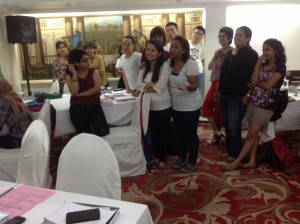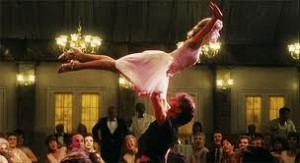Youth Advocacy Institute 2013 : Notes From Day One
 This year our youth champions from 2012 will report on the sessions for our blogs !! We are excited to invite Shreejana Bhajracharya to write about Day 1 !
This year our youth champions from 2012 will report on the sessions for our blogs !! We are excited to invite Shreejana Bhajracharya to write about Day 1 !
We, the Youth Champions from 2012 namely: Shreejana, Nikzad, Dakki, Yu Yung, Preet and Rola are very excited about co-facilitating sessions in 2nd YAI, 2013, and much more enthusiastic to meet other youth champions from different part of Asia because we are growing in number to advocate for our sexual and reproductive health and rights including safe abortion in our respective countries.
The first session on Day 1 started with a refreshing introduction to Sex and Gender by Manisha Gupte. Her sessions are always packed with new information and good examples which we can actually relate to it.
I still remember the example that she shared last year about blue and pink clothes for boy and girl children.When a child is born, everyone is initially curious to find oti if the child is a boy or a girl. A minute after the child is born its blue or pink blanket reveals whether it is boy child or girl child. Gender roles are thrust on the child right after its first breathe in the world. It reminded me of this 100-crore Hindi movie “3 Idiots” where the profession of a child is decided right after its birth.
 This year, I loved this example, highlighting an idea that was quite new to me: In Myanmar when clothes are dried, men’s clothes are always dried on the upper area of the house and women clothes are dried hidden inside the home where it cannot be seen by men. If they do see the undergarments of the females, men believe they will lose their masculinity. This might seem insane to some of us, but it is perceived as a truth among certain communities. But here is why this needs to be critiqued: this preferential way of hanging clothes affects sexual and reproductive health of women. We know that bacteria, fungi and virus easily survive in moist places. If our clothes are not dried properly especially in presence of sunlight these micro-organisms could affect our health.
This year, I loved this example, highlighting an idea that was quite new to me: In Myanmar when clothes are dried, men’s clothes are always dried on the upper area of the house and women clothes are dried hidden inside the home where it cannot be seen by men. If they do see the undergarments of the females, men believe they will lose their masculinity. This might seem insane to some of us, but it is perceived as a truth among certain communities. But here is why this needs to be critiqued: this preferential way of hanging clothes affects sexual and reproductive health of women. We know that bacteria, fungi and virus easily survive in moist places. If our clothes are not dried properly especially in presence of sunlight these micro-organisms could affect our health.
We also talked about how gender constructions change from community to community. The gender role assigned to male and female in Asia is different from Europe. Islamic people in Saudi have different gender roles than Islamic people in Indonesia. But difference is not the real problem. for example, yesterday I wore white and my friend Nikki wore red. This difference lent colours to our meeting room. It would be problematic if hierarchy were associated with these colours. This is what happens with the stereotypical male and female roles (masculinity and femininity quality) assigned by patriarchy. The different values assigned to these different roles creates a gender bias, and discrimination.
Then Rola held a discussion on gender roles in media. This is what I wanted to talk about as I am also a media person. I used to do an on-air youth radio program. Rola threw light on the stereotyping associated with the representation of women in media. She should be zero sized, beautiful, skinny and attractive but this does not apply to men in the media. People watching channels will not flip to a different channel if the male host of a show does not live up to the stereotypes, but will flip the channels if the woman is not as beautiful as they expect her to be. Portrayal of gender roles through media is traditional. Still women in advertisemens are shwon cleaning their home, using detergent, cooking and so on. Whereas you see men in advertisements for cars, motorbikes, etc. She cleared the media enhancing the gender roles by projecting a small video of Jon Stewart’s show, The daily show. It’s about a mother playing with her five year old son, who is shown to be wearing pink nail polish. Is this attack an masculinity? Some people think so.
This video was funny to almost everyone in the audience, abs shows how we internalize gender roles. Dr. Suchitra Dalvie added that this stereotyping could be violent in community as in North India, where a mother was mobbed by people for allowing her daughter to wear full length pair of jean with Knee-lenght shirt.
The session was now linked to human and reproductive rights. I want to make clear that reproductive rights are not separate from human rights. This part of the session was presented by Yu Yang, who talked about ICPD and MDG. It was a really helpful session as some of us are selected for UNESCAP that is going to be held in Bangkok from 11-21st of September, 2012. This session has empowered me by providing information about the unfinished agenda of ICPD and MDG that I could raise the meeting.
 The value regarding SRHR and safe abortion differs between individuals. Youth Advocate like me should be prepared to read the mind of those who don’t support abortion when I am talking about safe abortion. The session on value clarification was really interactive and participatory. I learnt how to answer to the questions or deal with the statement like “an abortion is ending a life”, or “choosing the sex of one’s child is a reproductive right” etc.
The value regarding SRHR and safe abortion differs between individuals. Youth Advocate like me should be prepared to read the mind of those who don’t support abortion when I am talking about safe abortion. The session on value clarification was really interactive and participatory. I learnt how to answer to the questions or deal with the statement like “an abortion is ending a life”, or “choosing the sex of one’s child is a reproductive right” etc.
Day 1 ended with the movie “Dirty Dancing”. I had watched this movie many years ago. This time the intention to see the movie again was to highlight the scenario of abortion within the movie and I also observed how women’s sexuality is shown in the movie. Its worthy of watching if you work for women’s right.






